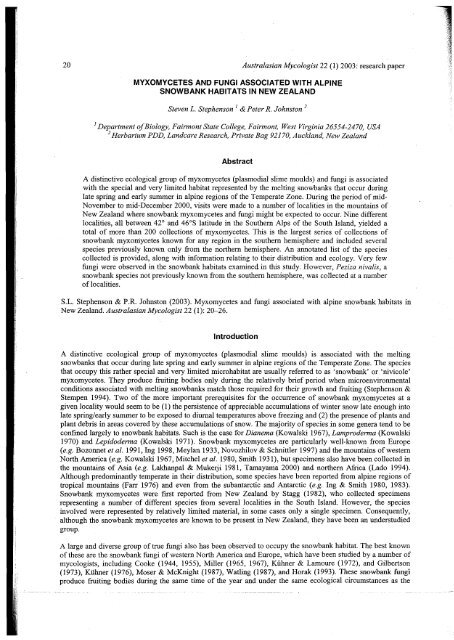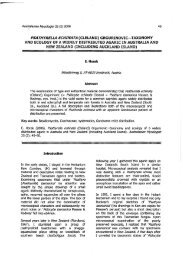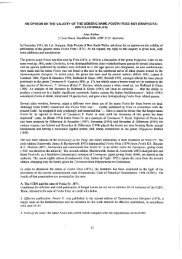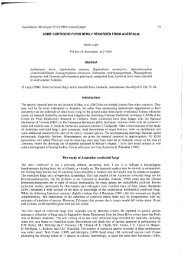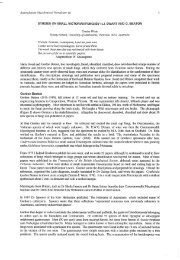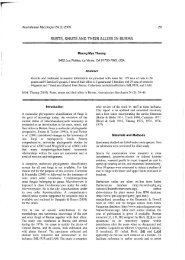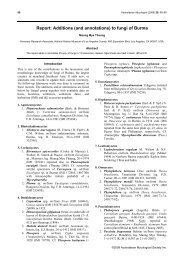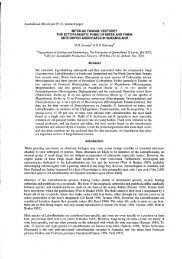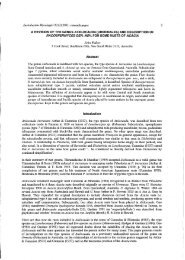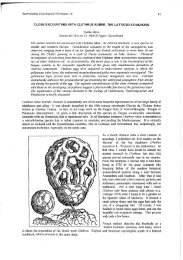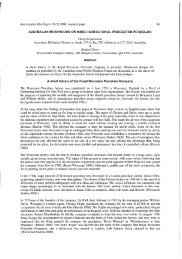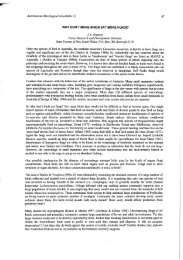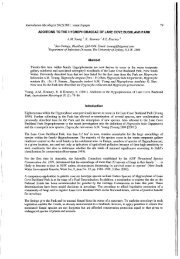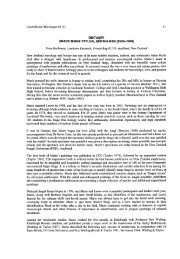Steven L. Stephenson 1 & Peter R. Johnston - The Australasian ...
Steven L. Stephenson 1 & Peter R. Johnston - The Australasian ...
Steven L. Stephenson 1 & Peter R. Johnston - The Australasian ...
You also want an ePaper? Increase the reach of your titles
YUMPU automatically turns print PDFs into web optimized ePapers that Google loves.
1<br />
MYXOMYCETES AND FUNGI ASSOCIATED WITH ALPINE<br />
SNOWBANK HABITATS IN NEW ZEALAND<br />
<strong>Steven</strong> L. <strong>Stephenson</strong> 1<br />
& <strong>Peter</strong> R. <strong>Johnston</strong> 2<br />
Department of Biology, Fairmont State College, Fairmont, West Virginia 26554-2470, USA<br />
2<br />
Herbarium PDD, Landcare Research, Private Bag 92170, Auckland, New Zealand<br />
Abstract<br />
A distinctive ecological group of myxomycetes (plasmodial slime moulds) and fungi is associated<br />
with the special and very limited habitat represented by the melting snowbanks that occur during<br />
late spring and early summer in alpine regions of the Temperate Zone. During the period of mid-<br />
November to mid-December 2000, visits were made to a number of localities in the mountains of<br />
New Zealand where snowbank myxomycetes and fungi might be expected to occur. Nine different<br />
localities, all between 42° and 46°S latitude in the Southern Alps of the South Island, yielded a<br />
total of more than 200 collections of myxomycetes. This is the largest series of collections of<br />
snowbank myxomycetes known for any region in the southern hemisphere and included several<br />
species previously known only from the northern hemisphere. An annotated list of the species<br />
collected is provided, along with information relating to their distribution and ecology. Very few<br />
fungi were observed in the snowbank habitats examined in this study. However, Peziza nivalis, a<br />
snowbank species not previously known from the southern hemisphere, was collected at a number<br />
of localities.<br />
S.L. <strong>Stephenson</strong> & P.R. <strong>Johnston</strong> (2003). Myxomycetes and fungi associated with alpine snowbank habitats in<br />
New Zealand. <strong>Australasian</strong> Mycologist 22 (1): 20-26.<br />
Introduction<br />
A distinctive ecological group of myxomycetes (plasmodial slime moulds) is associated with the melting<br />
snowbanks that occur during late spring and early summer in alpine regions of the Temperate Zone. <strong>The</strong> species<br />
that occupy this rather special and very limited microhabitat are usually referred to as 'snowbank' or 'nivicole'<br />
myxomycetes. <strong>The</strong>y produce fruiting bodies only during the relatively brief period when microenvironmental<br />
conditions associated with melting snowbanks match those required for their growth and fruiting (<strong>Stephenson</strong> &<br />
Stempen 1994). Two of the more important prerequisites for the occurrence of snowbank myxomycetes at a<br />
given locality would seem to be (1) the persistence of appreciable accumulations of winter snow late enough into<br />
late spring/early summer to be exposed to diurnal temperatures above freezing and (2) the presence of plants and<br />
plant debris in areas covered by these accumulations of snow. <strong>The</strong> majority of species in some genera tend to be<br />
confined largely to snowbank habitats. Such is the case for Dianema (Kowalski 1967), Lamproderma (Kowalski<br />
1970) and Lepidoderma (Kowalski 1971). Snowbank myxomycetes are particularly well-known from Europe<br />
(e.g. Bozonnet et al. 1991, Ing 1998, Meylan 1933, Novozhilov & Schnittler 1997) and the mountains of western<br />
North America (e.g. Kowalski 1967, Mitchel et al. 1980, Smith 1931), but specimens also have been collected in<br />
the mountains of Asia (e.g. Lakhanpal & Mukerji 1981, Tamayama 2000) and northern Africa (Lado 1994).<br />
Although predominantly temperate in their distribution, some species have been reported from alpine regions of<br />
tropical mountains (Farr 1976) and even from the subantarctic and Antarctic (e.g. Ing & Smith 1980, 1983).<br />
Snowbank myxomycetes were first reported from New Zealand by Stagg (1982), who collected specimens<br />
representing a number of different species from several localities in the South Island. However, the species<br />
involved were represented by relatively limited material, in some cases only a single specimen. Consequently,<br />
although the snowbank myxomycetes are known to be present in New Zealand, they have been an understudied<br />
group.<br />
A large and diverse group of true fungi also has been observed to occupy the snowbank habitat. <strong>The</strong> best known<br />
of these are the snowbank fungi of western North America and Europe, which have been studied by a number of<br />
mycologists, including Cooke (1944, 1955), Miller (1965, 1967), Kiihner & Lamoure (1972), and Gilbertson<br />
(1973), Kiihner (1976), Moser & McKnight (1987), Watling (1987), and Horak (1993). <strong>The</strong>se snowbank fungi<br />
produce fruiting bodies during the same time of the year and under the same ecological circumstances as the
snowbank myxomycetes. Fungi occurring in the snowbank habitat in western North America include both<br />
ascomycetes and basidiomycetes. <strong>The</strong> majority of these are associated with decaying litter or wood, but a few<br />
ectomycorrhizal species {e.g. members of the genus Cortinarius) have been reported from snowbank habitats<br />
(Miller 1965). Although suitable habitats certainly exist in New Zealand, particularly in the Southern Alps, there<br />
are apparently no published accounts of snowbank fungi from anywhere in the country.<br />
<strong>The</strong> primary objective of the study reported herein was to obtain the body of data required to develop a more<br />
complete understanding of the distribution and ecology of the myxomycetes associated with snowbanks in alpine<br />
areas of New Zealand. A secondary objective was to collect and study any fungi found in these same alpine<br />
snowbank habitats.<br />
Materials and Methods<br />
During the period of mid-November to mid-December 2000, visits were made to study sites at a number of<br />
localities in the mountains of New Zealand where snowbank myxomycetes and fungi might be expected to occur<br />
(Fig. 2). With few exceptions, the localities visited were ski fields. <strong>The</strong>re were two reasons why this was the<br />
case. Firstly, information on the persistence of snowbanks late into the season and in ecologically suitable<br />
habitats was more readily available for ski areas than for other potential study sites. Secondly, most ski areas are<br />
accessible by roads or tracks. Each study site was referenced to geographic location through the use of a portable<br />
GPS receiver, and the digitised NZMS 260 map series available on MapWorld NZ v.2.0.74 was used to<br />
determine the approximate elevation.<br />
In each study site at a particular locality, potential substrates at or near the edges of melting snowbanks (Fig. 3)<br />
were examined carefully for myxomycete fruiting bodies, and any specimens present were collected. A<br />
'collection' was defined as one or more fruiting bodies sharing the same substrate and considered to have<br />
originated from a single Plasmodium (<strong>Stephenson</strong> 1988). In virtually all cases, this could be determined without<br />
difficulty. <strong>The</strong> method used in making a collection involved removing all or most of the fruiting bodies along<br />
with a portion of the substrate upon which they occurred. Collections of myxomycetes were returned to the<br />
laboratory, air-dried and glued in small boxes for permanent storage. Identifications of collections were made<br />
using the descriptions and keys provided by Martin & Alexopoulos (1969) or by comparison with specimens<br />
obtained on loan from the National Fungus Collections (BPI). Vouchers of all species reported herein are<br />
deposited in the herbarium of Fairmont State College (FWVA) or the New Zealand Fungal Herbarium (PDD),<br />
maintained by Landcare Research in Auckland.<br />
TB<br />
J<br />
/<br />
Sporocarps of fungi observed during the survey for<br />
myxomycetes also were collected. In many instances, these<br />
were photographed in the field. Later, sporocarps were<br />
preserved for further study by drying on the shelves of a small<br />
mushroom dryer.<br />
Results<br />
Nine localities, all between 42° and 46°S latitude in the<br />
Southern Alps of the South Island (Fig. 1), yielded collections<br />
of snowbank myxomycetes. Four of these same localities also<br />
yielded collections of Peziza nivalis, one of the very few fungi<br />
observed in the snowbank habitats examined in the present<br />
study. Visits to a number of other localities, including one<br />
near the Fox Glacier on the west coast of the South Island and<br />
two in Tongariro National Park in the North Island, did not<br />
produce any collections of 'true' snowbank myxomycetes or<br />
fungi.<br />
Figure 1. Locations of snowbank study sites examined in the<br />
present study. Abbreviations used for the localities are given in<br />
Table 1.
<strong>The</strong> nine localities listed in Table 1 yielded a total of more than 200 collections of myxomycetes, the largest<br />
series of collections known for any region in the entire southern hemisphere. At least 13 species were<br />
represented among the 193 collections that were mature enough to be identified. <strong>The</strong>se included several species<br />
not previously known from the southern hemisphere. <strong>The</strong> number of species recorded for a particular locality<br />
ranged from two (MH) to 10 (OM-2).<br />
Table 1. Localities from which snowbank myxomycetes and fungi were collected.<br />
Locality Location Elevation Date visited<br />
TJ3 - Temple Basin ski field 42°54'35"S, 171°34'35"E 1400 m 28 Nov. 2000<br />
BR - Broken River ski field 43°07'32"S, 171°40'57"E 1580 m 11 Dec. 2000<br />
MH-MtHutt ski field 43°29'44"S, 171°32T2"E 1600 m 11 Dec. 2000<br />
MD - Mt Dobson ski field 43°S6'33"S, 170°39'53"E 1770 m 9 Dec. 2000<br />
OH - Oahu ski field 44°13'19"S, 169°46'47"E 1525 m 9 Dec. 2000<br />
CA - Cardrona ski field 44°52'20"S, 168°56'48"E 1680 m 7 Dec. 2000<br />
RE - Remarkables ski field 45°03'16"S, 168°49'00"E 1650 m 7 Dec. 2000<br />
OM-1 - Old Man Range site 1 45°18'50"S, 169°11'44"E 1650 m 8 Dec. 2000<br />
OM-2 - Old Man Range site 2 45°22'32"S, 169°12'22"E 1610m 8 Dec. 2000<br />
Annotated List of Species<br />
Nomenclature used herein for myxomycetes follows Lado (2001). Numbers of collections and collecting<br />
localities are indicated for each species.<br />
Diderma alpinum (Meyl.) Meyl.<br />
This species was first reported from New Zealand by Stagg (1982), based on specimens collected in the vicinity<br />
of Castle Rock Hut, located near the Franz Josef Glacier; from the vicinity of Lake Mavis above Goat Pass in<br />
Arthur's Pass National Park; and on the lower south slopes of Mount Ruapehu. Diderma alpinum, which was<br />
represented by 67 collections, was the single most common snowbank myxomycete encountered in the present<br />
study and was recorded from BR, MD, OH, CA, RE, OM-1 and OM-2. It is also known from North America,<br />
Europe and Asia.<br />
Diderma niveum (Rostaf.) T. Macbr.<br />
Although not previously known from New Zealand, this species was collected from MD, OH, OM-1 and OM-2.<br />
Diderma niveum resembles D. alpinum but differs in being more clearly sporangiate. It is one of the most<br />
common and widely distributed of the snowbank myxomycetes, having been reported from numerous localities<br />
in North America, Europe and Asia as well as from the Antarctic Peninsula in the southern hemisphere (Ing &<br />
Smith 1983). <strong>The</strong> species does not appear to be particularly common in New Zealand, and none of the eight<br />
collections consisted of more than a few sporangia.<br />
Didymium dubium Rostaf. (Fig. 6)<br />
This species was first reported from New Zealand by Stagg (1982), based on specimens collected above Castle<br />
Rock Hut, located near the Franz Josef Glacier; on the ridges of Temple Peak towards Goat Pass; and around<br />
Lake Mavis in Arthur's Pass National Park. In the present study, D. dubium was recorded from RE, OM-1, OM-<br />
2, TB, CA and CR. With a total of 27 collections, it was the third most common species encountered in the<br />
present study. Didymium dubium also has been recorded from North America, Europe and Asia as well as from<br />
Signy Island in the subantarctic (Ing & Smith 1983).<br />
Lamproderma atrosporum Meyl. (Fig. 7)<br />
This species was first reported from New Zealand by Stagg (1982), based on specimens collected from the<br />
vicinity of Castle Rock Hut, located near the Franz Joseph Glacier. In the present study, L. atrosporum was<br />
represented by six collections and was recorded from MD, OH and OM-1. It is also known from North America,<br />
Europe and Asia.<br />
Lamproderma ovoideum Meyl.<br />
Although not known previously from New Zealand, this species was recorded from MH and OM-2 in the present<br />
study. It does not appear to be particularly common, since only three collections were recorded. Lamproderma<br />
ovoideum was described originally from Europe and is now known from North America, Asia and subantarctic<br />
Macquarie Island (<strong>Stephenson</strong> et al. 1992).
Figures 2-9. New Zealand snowbanks, myxomycetes and fungi. Fig. 2. Alpine snowbanks (Mt Hurt ski field).<br />
Fig. 3. Melting snowbanks (Cardrona ski field). Fig. 4. Snowbank myxomycetes fruiting at the edge of a melting<br />
snowbank (Mt Dobson ski field). Fig. 5. Fruiting bodies of Physarum alpinum (Remarkables ski field). Fig. 6.<br />
Fruiting bodies of Didymium dubium (Cardrona ski field). Fig. 7. Lamproderma atrosporum fruiting on a living<br />
Celmisia leaf (Old Man Ridge, site 1). Fig. 8. Peziza nivalis (Broken River ski field). Fig. 9. Peziza nivalis (Oahu<br />
ski field).<br />
Lamproderma splendens Meyl.<br />
This species was not known from New Zealand prior to the present study, but it was collected from MH, TB,<br />
RM, OM-2 and CR. Lamproderma splendens was represented by a total of seven collections. It is also known<br />
from Europe and Asia.<br />
Lepidoderma carestianum (Rab.) Rostaf.<br />
This species was first reported from New Zealand by Stagg (1982), based on specimens collected from the<br />
vicinity of Castle Rock Hut, located near the Franz Josef Glacier. It appears to be relatively common in alpine<br />
snowbank habitats in New Zealand and was represented by 21 collections from six localities (TB, BR, MD, CA,<br />
OM-1 and OM-2). <strong>The</strong> species also has been reported from North America, Europe, Asia and Australia (Mitchell<br />
1995).
Lepidoderma crustaceum Kowalski<br />
Our collections represent the first New Zealand records for this species, which was described originally from<br />
North America and has since been reported from Europe (Schnittler & Novozhilov 1999). In the present study,<br />
L. crustaceum (a total of eight collections) was recorded from CA, RE and OM-2.<br />
Lepidoderma granuliferum (W'. Phillips) R.E. Fr.<br />
This species was first reported from New Zealand by Stagg (1982), based on a specimen collected in the vicinity<br />
of Castle Rock, located near the Franz Josef Glacier. Lepidoderma granuliferum appears to be rare in New<br />
Zealand and was recorded only once (from OM-2) in the present study. Described originally from North<br />
America, this species is also known from Asia.<br />
Peziza nivalis (R. Heim & L. Remy) M.M. Moser (Figs 8 & 9)<br />
Although widely reported from snowbank habitats in Europe and North America (Pfister 1992), our collections<br />
are the first records of this snowbank discomycete from the southern hemisphere. Represented by collections<br />
from four localities (BR, MD, OH, RE), P. nivalis appears to be common in New Zealand.<br />
Physarum albescens Ellis ex T. Macbr.<br />
This species was first reported from New Zealand by Stagg (1982), based on specimens collected on Molte Peak<br />
above Castle Rock Hut, near Franz Josef Glacier. In the present study, it was represented by just five collections<br />
and was recorded from CA, OM-1 and RM. Physarum albescens also has been reported from North America,<br />
Europe and Asia.<br />
Physarum alpestre Mitchel, S.W. Chapman. & M.L. Farr<br />
This species has not always been recognized as distinct from Physarum alpinum (see below), and the two species<br />
are certainly very close. However, P. alpestre is mainly plasmodiocarpous while P. alpinum is primarily<br />
sporangiate; the spores of the former are more strongly warted than is the case for the latter; and fruitings of<br />
P. alpestre usually are found on the stems of dead grasses instead of decaying wood, the usual substrate for<br />
P. alpinum. In the present study, specimens that appear to represent P. alpestre were collected on two occasions,<br />
both from CA. <strong>The</strong> species also has been collected in North America, Europe and Asia.<br />
Physarum alpinum (Lister & G. Lister) G. Lister (Fig. 5)<br />
Although not reported by Stagg (1982), this species appears to be among the most common snowbank<br />
myxomycetes in New Zealand. Twenty-nine collections were recorded in the present study; these came from five<br />
localities (MD, CA, RE, OM-1 and OM-2). Physarum alpinum is also known from North America, a highelevation<br />
site in the Venezuelan Andes of South America (Farr 1976) and Europe.<br />
Physarum sp.<br />
Myxomycetes that belong to the order Physarales (and thus characterized by the presence of lime in the fruiting<br />
body) sometimes produce nearly limeless fruitings in calcium-deficient situations. Two specimens (both from<br />
OM-2) collected in the present study consist of numerous sporangia that seem to have developed normally but<br />
which show no evidence of lime. In the field, they were identified tentatively as Diacheopsis. Microscopic<br />
examination of these specimens in the laboratory did not produce a conclusive identification, although the<br />
general aspect of the fruiting bodies and features of the spores suggested a limeless Physarum, although not one<br />
that could be assigned readily to any of the other species in the genus collected in the present study. As such, the<br />
two specimens appear to represent a distinct, but as yet undetermined, taxonomic entity.<br />
Trichia contorta (Ditmar) Rostaf.<br />
This species is not a true snowbank myxomycete but small fruitings sometimes were encountered on dead leaves<br />
(e.g. those of Celmisia spp.) and other plant debris in alpine snowbank habitats. Most of our collections were old<br />
and probably date from the previous summer. As will be noted below, fruitings of most species of myxomycetes<br />
do not persist for this length of time. Trichia contorta is a rather variable species that appears to have a<br />
distribution centered in the Temperature Zone. It has been reported from both Australia (Mitchell 1995) and New<br />
Zealand (Mitchell 1992).
Discussion<br />
Most of the snowbanks examined in the present study occurred in alpine areas dominated by tussock grass<br />
(Chionochloa spp.) communities, and the majority (66%) of all collections were associated with substrates<br />
consisting at least in part of grass litter. Stagg (1982) mentioned that specimens he collected 'were usually found<br />
fruiting on snow tussock {Chionochloa sp.), occasionally on herbs'. In our collections, various living plants<br />
(including grasses and broadleaf herbs) represented all or part of the substrate for approximately 40% of all<br />
specimens. Didymium dubium was particularly noteworthy in this respect, and the broadly effused grey<br />
plasmodiocarps of this species were conspicuous against the green background of the living leaves upon which<br />
they occurred (Fig. 6). Almost invariably, fruitings of all of the species of snowbank myxomycetes encountered<br />
in the present study occurred near the edge (usually within a metre) of a melting snowbank (Fig. 4).<br />
Because the treeline in the mountains of New Zealand is relatively low and usually does not extend into the<br />
alpine habitats where snowbanks occur, those species of snowbank myxomycetes typically associated with<br />
coarse woody debris were not represented among the specimens collected in the present study. <strong>The</strong> absence of<br />
woody substrates in alpine areas also would seem to represent an ecological factor of some importance for fungi,<br />
since many of the more common and conspicuous species reported from snowbank habitats in western North<br />
America occur on wood. Except for a relatively few examples (e.g. Dracophyllum), woody shrubs are not<br />
common in alpine snowbank habitats of New Zealand. This is quite unlike the situation that exists for<br />
comparable habitats in the mountains of the northern hemisphere, where woody shrubs (e.g. Vaccinium spp.) are<br />
often not only abundant but also appear to provide a particularly good substrate for snowbank myxomycetes.<br />
Based on the data obtained in the present study, Diderma alpinum, Physarum alpinum, Didymium dubium, and<br />
Lepidoderma carestianum are the most commonly encountered myxomycetes in alpine snowbank habitats of<br />
New Zealand. Together, these four species—all members of the Order Physarales—made up 75% of all<br />
collections that could be identified. <strong>The</strong> relatively small number of collections of members of Lamproderma<br />
represented among our collections was surprising, based upon the first author's own collecting experiences in<br />
both western North America and Europe, where this taxon tends to be especially abundant and diverse in<br />
snowbank habitats. Interestingly, in these northern hemisphere localities, fruitings of Lamproderma frequently<br />
occur on the stems and branches of woody shrubs.<br />
As a result of their limited ecological distribution and the fact that they fruit during what (at least for most fungi)<br />
is an unusual time of the year, snowbank myxomycetes are not likely to be encountered by most mycologists.<br />
Moreover, the fact that their fruiting bodies do not persist for very long in nature also places a severe constraint<br />
on studies of the group. For example, we revisited the locality (TB) that yielded our first collections of snowbank<br />
myxomycetes (in November 2000) approximately two weeks later. Careful searching of some of the same<br />
microsites that had yielded collections in November produced nothing on this second visit. In March of 2001, the<br />
first author revisited one of the localities (RE) where snowbank myxomycetes had been particularly abundant<br />
three months earlier, but there was no evidence of even old, weathered fruitings.<br />
Acknowledgements<br />
This research project was supported by a grant (INT-9819812) from the National Science Foundation. <strong>The</strong><br />
second author was also funded by the New Zealand Foundation for Research, Science and Technology. <strong>The</strong> New<br />
Zealand Department of Conservation provided permits allowing collections to be made from National Parks and<br />
Reserves, and the operators of all ski fields visited are thanked for their assistance and advice. <strong>The</strong> assistance of<br />
Dawn Black, Maribeth Overking and Sarah Marr in carrying out fieldwork is gratefully acknowledged.<br />
Appreciation is extended to Marianne Meyer for her comments on several specimens of Lamproderma.<br />
References<br />
Bozonnet, J., Meyer, M. & Poulain, M. (1991). Especes nivales de myxomycetes. Societe d'Histoire Naturelle<br />
du Pays de Montbeliard 1991, 51-72.<br />
Cooke, W.B. (1944). Notes on the ecology of the fungi of Mount Shasta. American Midland Naturalist 31, 237-<br />
249.<br />
Cooke, W.B. (1955). Subalpine fungi and snowbanks. Ecology 36,124-130.<br />
Farr, M.L. (1976). Flora Neotropica Monograph No.16. Myxomycetes. <strong>The</strong> New York Botanical Garden, Bronx,<br />
New York.
Gilbertson, R.L. (1973). Notes on some corticioid lignicolous fungi associated with snowbanks in southern<br />
Arizona. Persoonia 7, 171-182.<br />
Horak, E. (1993). Entoloma in the alpine zone of the Alps: 1. Revision of the taxa described by J. Favre (1955).<br />
2. New records from the Swiss National park and other locations in the Alps. Bibliotheca Mycologica 150, 63-<br />
91.<br />
Ing, B. (1998). Alpine myxomycetes in Scotland. BotanicalJournal of Scotland 50,47-53.<br />
Ing, B. & Smith, R.I.L. (1980). Two myxomycetes from South Georgia. British Antarctic Survey Bulletin<br />
50, 118-120.<br />
Ing, B. & Smith, R.I.L. (1983). Further myxomycete records from South Georgia and the Antarctic Peninsula.<br />
British Antarctic Survey Bulletin 59, 80-81.<br />
Kowalski, D.T. (1967). Observations on the Dianemaceae. Mycologia 59, 1075-1084.<br />
Kowalski, D.T. (1970). <strong>The</strong> species of Lamproderma. Mycologia 62, 621-672.<br />
Kowalski, D.T. (1971). <strong>The</strong> genus Lepidoderma. Mycologia 63,490-516.<br />
Kiihner, R. (1976). Agaricales de la zone alpine. Bulletin Trimestrial de la Societe Mycologique de France<br />
92,455-515.<br />
Kiihner, R. & Lamoure, D. (1972). Agaricales de la zone alpine, Clitocybe. Travaux Scientificques du Pare<br />
National de la Vanoise 2, 107-152.<br />
Lado, C. (1994). A checklist of myxomycetes of the Mediterranean countries. Mycotaxon 70,117-185.<br />
Lado C. (2001). Nomenmyx. A Nomenclatural Taxabase of Myxomycetes. Cuadernos de Trabajo Flora<br />
Micologica Iberica 16,1-221.<br />
Lakhanpal, T.N. & Mukerji, K.G. (1981). Taxonomy of the Indian myxomycetes. Bibliotheca Mycologica 78, 1-<br />
531.<br />
Martin, G.W. & Alexopoulos, C.J. (1969). <strong>The</strong> Myxomycetes. University of Iowa Press, Iowa City.<br />
Meylan, C. (1933). Recherches sur les Myxomycetes du Jura 1930-31-32. Bulletin de la Societe Vaudoise des<br />
Sciences Naturelles 58, 81-90.<br />
Miller, O.K. (1965). Snowbank mushrooms in the Three Sisters Wilderness Area. Mazama 47,38-41.<br />
Miller, O.K. (1967). Notes on western fungi. Mycologia 59, 504-512.<br />
Mitchel, D.H., Chapman, S.W. & Farr, M.L. (1980). Notes on Colorado fungi IV: Myxomycetes. Mycotaxon<br />
10, 299-349.<br />
Mitchell, D.W. (1992). <strong>The</strong> Myxomycota of New Zealand and its island territories. Nova Hedwigia 55,231-256.<br />
Mitchell, D.W. (1995). <strong>The</strong> Myxomycota of Australia. Nova Hedwigia 60,269-295.<br />
Moser, M. & McKnight, K.H. (1987). Fungi (Agaricales, Russulales) from the alpine zone of Yellowstone<br />
National Park and the Beartooth Mountains with special emphasis on Cortinarius, in G.A. Laursen,<br />
J.F. Ammirati & S.A. Redhead (eds), Arctic and Alpine Mycology III, 229-317. Plenum Publishing, New<br />
York.<br />
Novozhilov, Y.K. & Schnittler, M. (1997). Nivicole myxomycetes of the Chibine Mountains (Kola Peninsula).<br />
Nordic Journal of Botany 16, 549-561.<br />
Pfister, D.H. (1992). A collection of Peziza nivalis from California with comments on the nomenclature of the<br />
snow bank pezizas. Mycotaxon 43,171-175.<br />
Schnittler, M. & Novozhilov, Y.K. (1999). Lepidoderma crustaceum, a nivicolous myxomycete, found on the<br />
island of Crete. Mycotaxon 71, 387-392.<br />
Smith, E.C. (1931). Ecological observations on Colorado myxomycetes. Torreya 31,42-44.<br />
Stagg, B.M. (1982). <strong>The</strong> myxomycetes of New Zealand. M.S. <strong>The</strong>sis, California State University, Chico.<br />
Unpublished.<br />
<strong>Stephenson</strong>, S.L. (1988). Distribution and ecology of myxomycetes in temperate forests. I. Patterns of<br />
occurrence in the upland forests of southwestern Virginia. Canadian Journal of Botany 66, 2187-2207.<br />
<strong>Stephenson</strong>, S.L., Seppelt, R.L. & Laursen, G.A. (1992). <strong>The</strong> first record of a Myxomycete from subantarctic<br />
Macquarie Island. Antarctic Science 4,431-432.<br />
<strong>Stephenson</strong>, S.L. & Stempen, H. (1994). Myxomycetes: a Handbook of Slime Molds. Timber Press, Portland,<br />
Oregon.<br />
Tamayama, M. (2000). Nivicolous taxa of the myxomycetes in Japan. Stapfia 73, 121-129.<br />
Watling, R. (1987). Larger arctic-alpine fungi in Scotland, in G.A. Laursen, J.F. Ammirati & S.A. Redhead<br />
(eds), Arctic and Alpine Mycology III, 17—45. Plenum Publishing, New York.


